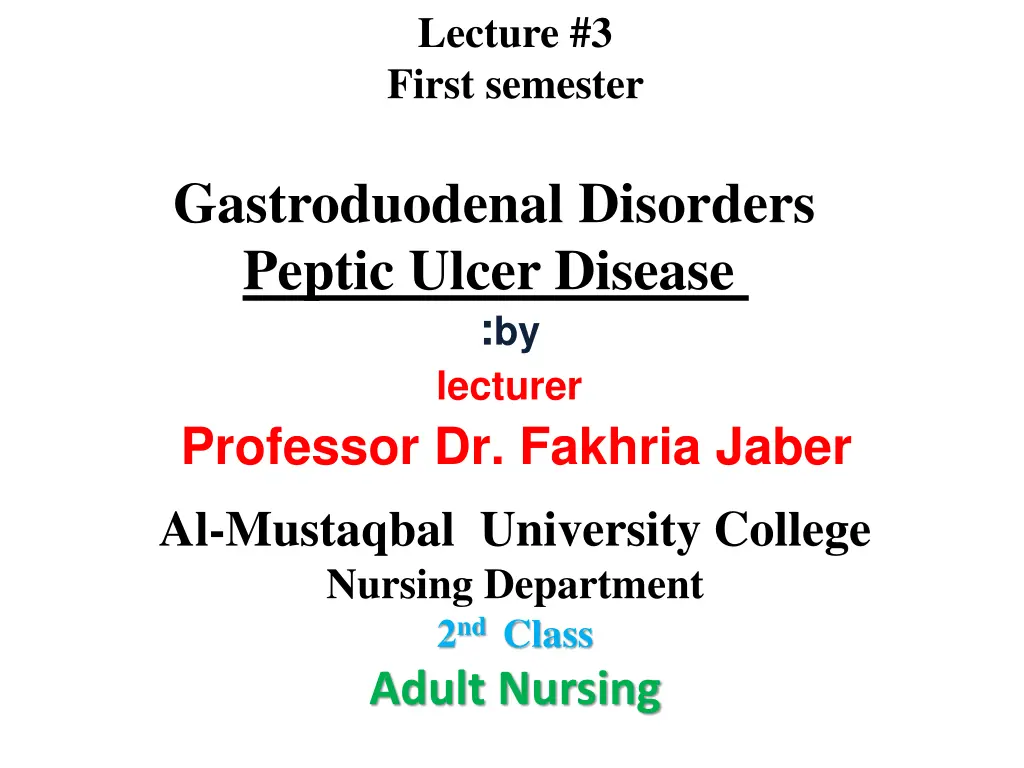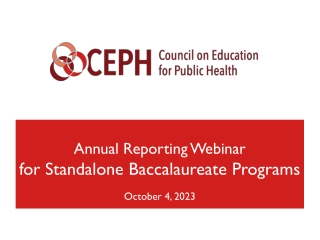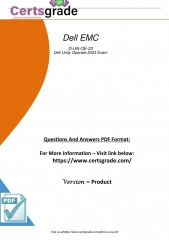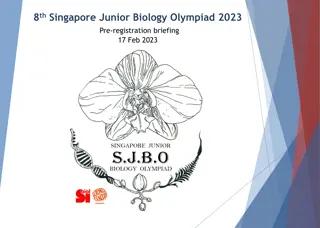
Understanding Peptic Ulcer Disease: Causes, Symptoms, and Management
Peptic ulcer disease involves lesions in the mucosa of the lower esophagus, stomach, pylorus, or duodenum. This condition can result from various factors such as Helicobacter pylori infection, NSAID use, hypersecretion of acid, genetic predisposition, and stress. Patients may experience different clinical manifestations based on whether they have gastric or duodenal ulcers, with symptoms like pain, weight changes, and black or tarry stools. Proper understanding of the pathophysiology and etiology is crucial for effective management of peptic ulcer disease.
Download Presentation

Please find below an Image/Link to download the presentation.
The content on the website is provided AS IS for your information and personal use only. It may not be sold, licensed, or shared on other websites without obtaining consent from the author. If you encounter any issues during the download, it is possible that the publisher has removed the file from their server.
You are allowed to download the files provided on this website for personal or commercial use, subject to the condition that they are used lawfully. All files are the property of their respective owners.
The content on the website is provided AS IS for your information and personal use only. It may not be sold, licensed, or shared on other websites without obtaining consent from the author.
E N D
Presentation Transcript
Lecture #3 First semester Gastroduodenal Disorders Peptic Ulcer Disease :by lecturer Professor Dr. Fakhria Jaber Al-Mustaqbal University College Nursing Department 2nd Class Adult Nursing
Peptic Ulcer Disease A peptic ulcer is a lesion in the mucosa of the lower esophagus, stomach, pylorus or duodenum. The stomach is divided on the basis of the physiologic function into two main portions: 1) The proximal two third, the fundic gland area, acts as a receptacle for ingested food and secrete acid and pepsine. 2) The distal third, the pyloric gland area, mixes and propels food into the duodenum and produces the hormone gastrein. "Peptic" lesions may occur in the esophagus (esophagitis), stomach, (gastritis), or duodenum (duodenities).
Note peptic ulcer sites and common inflammatory sites in the previous Fig.
Pathophysiology/Etiology 1) Helicobacter pylori infection exact mechanism is unclear. 2) Non steroidal anti-inflammatory drug (NSAID) induced ulcers. a. The risk of gastric ulcers is much greater than duodenal ulcers. b. Aspirin is the most ulcerogenic NSAID. 3) Hyper secretion of acid: a. Believed to be caused by an overactive vagus nerve, which stimulates the release of gastrin. b. Methylxanthines (tea, coffee, cola, and chocolate) and smoking may also increase gastric acidity c. Found in disorders such as Zollinger-Ellison syndrome tumors of the pancreas which increases secretion of gastrin(multiple peptic ulcers). 4) Genetic predisposition and stress appear to be controversial factors.
Clinical Manifestations Gastric ulcers Duodenal ulcers Lesion. Superficial; smooth margins; round, oval or cone shaped. Antrum. Also in body and fundus of the stomach. Pain occurring in the high left epigastric area radiating to the back & upper abdomen Described as dull, aching, and gnawing Penetrating Location of lesion. First 1-2 cm of duodenum. Pain located to the right of the midline epigastric region radiating to the back Describes as burning , cramping, pressure like pain across midepigastrium & upper abdomen Pain may increase when the stomach is empty, approximately 1 to 3 hours after eating. Clinical Manifestations Pain is worse with food
Not relieved with antacids as well as with duodenal Patients may report relief from pain after eating or taking antacids Some clients have constant pain or no clear pattern of discomfort Pain may awaken person at night, periodic and episodic Clinical Manifestations Weight loss Weight gain if food relieves the pain Black or tarry stools from bleeding
Diagnostic Evaluation 1. Upper GI series usually outlines ulcer or area of inflammation. 2. Fiberoptic panendoscopy (esophagogastroduodenoscopy) visualization of duodenal mucosa; identifies inflammatory changes, ulcers, lesions, bleeding sites, and malignancy. 3. Cytologic brushings and biopsies may be performed to obtained samples. 4. Serial stool specimens to detect occult blood 5. Gastric secretory studies (gastric acid secretion test and the serum gastric level test) elevated in Zollinger-Ellison syndrome 6. Serum test for H. pylori antibodies may be positive.
Management A. 1) H2 receptor antagonists, such as cimetidine (Tagamet), ranitidine (Zantac), famotidine (Pepcid) inhibit action of histamine on the H2 receptors of the parietal cells, thus reducing gastric acid output and concentration. 2) Antisecretory or proton pump inhibitor drug omeprazole (Prilosec) inhibits the production of hydrochloric acid in the stomach. Heals ulcers quickly (in 4 to 8 weeks). 3) Cytoprotective drug sucralfate (Carafate) adheres to and protects the ulcer surface by forming a protective barrier against acid, bile, pepsin. 4) Acid-neutralizing agents (antacids) provide additional relief of symptoms. Not used alone as treatment. Specific Pharmacotherapy
5) Antisecretory and cytoprotective drug misoprostol (Cytotec) prostoglandin analogue inhibits hydrochloric acid production in the stomach. 6) Antidiarrheal agent bismuth subsalicylate (Pepto-Bismol) has antibacterial action against H. pylori and enhances mucosal protection through bicarbonate and prostaglandin production. 7) Antibiotics such as tetracycline and metronidazole (Flagyl) used with bismuth as triple therapy to eradicate H. pylori. 8) For NSAID ulcers discontinue NSAID and treat as mentioned above. If NSAID is restarted, administer with misoprostol.
B. Dietary Measures 1)Well-balanced diet, high fiber content, meals at regular intervals ( 6 meals a day). 2)Avoid caffeine, colas, and alcohol. 3)Avoid smoking decreases healing rate and increases recurrence. C. Surgery Indicated in emergency situations for uncontrolled bleeding or bleeding that developed despite chronic drug maintenance therapy.
1) Vagotomy: (cutting of vagus nerve) To eliminate the stimulus that triggers gastric acid secretion by the gastric cells; can choose to cut all or portions 2) Subtotal gastrectomy a. The resected portion includes a small cuff of the duodenum, pylorus, and from two thirds to three quarters of the stomach. b. The duodenum or side of the jejunum is anastomosed to the remaining portion of the stomach. 3) Total gastrectomy esophagus is anastomosed to jejunum Complications 1) GI hemorrhage 2) Ulcer perforation 3) Gastric outlet obstruction
Nursing Assessment 1) Determine location, character, radiation of pain, factors aggravating or relieving pain, how long it lasts, when it occurs. 2) Ask about eating patterns, regularity, types of food, eating circumstances. 3) Take a social history of alcohol consumption and smoking. 4) Ask about medications (especially aspirin, anti- inflammatory drugs, or steroids). 5) Determine if GI bleeding has been experienced. 6) Take vital signs, including lying, standing, and sitting blood pressures and pulses, to determine if orthostasis is present due to bleeding.
Nursing Diagnoses A.Fluid Volume Deficit related to hemorrhage B.Pain related to epigastric distress secondary to hypersecretion of acid, mucosal erosion, or perforation C.Diarrhea related to GI bleeding or antacid therapy D.Altered Nutrition, Less Than Body Requirements, related to the disease process E.Knowledge Deficit related to physical, dietary, and pharmacologic treatment of disease.
Nursing Interventions A. 1) Monitor intake and output continuously to determine fluid volume status. 2) Observe stools for occult blood. 3) Monitor hemoglobin and hematocrit and electrolytes. 4) Administer prescribed IV fluids and blood replacement, as prescribed. 5) Insert an NG tube as prescribed and monitor the tube drainage for signs of visible and occult blood. 6) Administer medications through the NG tube to neutralize acidity, as prescribed. 7) Prepare patient for saline lavage, as ordered. 8) Observe the patient for an increase in pulse and a decrease in blood pressure (signs of shock). Avoiding Fluid Volume Deficit
B. Achieving Pain Relief 1) Encourage bed rest to reduce physical activity and to separate patient from usual environment if pain continues. 2) Provide small, frequent meals to prevent gastric distention if not NPO. 3) Teach the patient that caffeine, alcoholic beverages, and nicotine may increase gastric acidity and promote erosion of the gastric mucosa. 4) Advise the patient about the irritating effects on the gastric mucosa of certain drugs, such as aspirin, NSAIDs, and certain antibiotics. 5) Administer prescribed medication
Decreasing Diarrhea 1) Monitor patient s elimination patterns to determine effects of medications. 2) Monitor vital signs and watch for signs of hypovolemia. Persistent diarrhea may be a sign of bleeding. 3) Restrict foods and fluids that promote diarrhea: raw vegetables, fruits, whole grain cereals, carbonated drinks. 4) Administer antidiarrheal medication as prescribed. 5) Watch for signs of impaired skin integrity (erythema, soreness) around anus to promote comfort and decrease risk of infection.
D. Achieving Adequate Nutrition 1) Eliminate foods that cause pain or distress; otherwise, the diet is usually not restricted. 2) Provide small, frequent feedings on time. This will decrease distention and the release of gastrin. Frequent feedings also help neutralize gastric secretions and dilute stomach contents. However, eating small, frequent meals or snacks can lead to acid rebound, which occurs 2 to 4 hours after eating. 3) Advise the patient to avoid coffee and other caffeinated beverages as well as carbonated drinks; these may increase acid. 4) Advise the patient to avoid extremely hot or cold food or fluids, to chew thoroughly, and to eat in a leisurely fashion for better digestion. 5) Administer parenteral nutrition if bleeding is prolonged and patient is emaciated, as ordered.






















